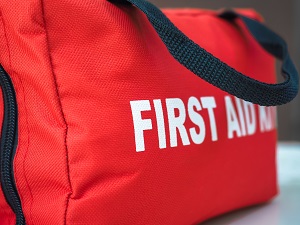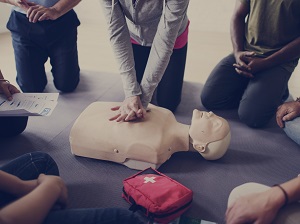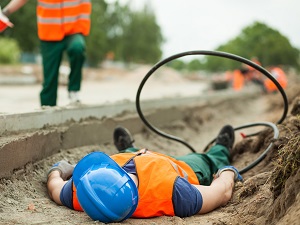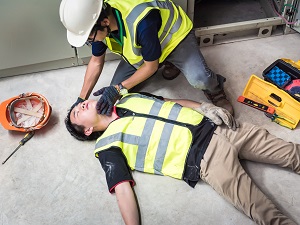What are the most vital first aid procedures for the skilled trades industry? Learn more about the first aid basics that are a good foundation for your workforce.

Skilled trade is defined as any occupation requiring special ability, knowledge or skills that can be obtained through technical schools, colleges or specialized training. In other words, pretty much everyone in the vocational workforce. That means that just as you need to teach your staff about safety inspections and protocols, they should be advised of different first aid applications.
OSHA does not strictly require every workplace to conduct first aid training, but they do strongly recommend that at least one employee be properly certified in first aid procedures, including CPR on adults.
OSHA regulations say that emergency medical services must be accessible within reasonable distances and timeframes. This is also relatively general, but what is clear is that responsible employers will do all in their power to ensure the health and safety of their workforce. That includes instruction in the first aid methods that OSHA describes and recommends, which are listed below.

Principles of Triage
As an umbrella term, first aid covers everything from band aids to cover small scratches to epileptic seizures where individuals need to be put into the recovery position. With such a broad scope, it’s important to be able to triage situations where there is more than one person requiring attention. Everyone who will benefit from assistance should be seen to, from most to least serious conditions.
Methods of Surveying the Scene and Victims
Workers who are trained in first aid should be able to do more in accident or emergency situations than triage the people in need of medical attention. They also need to survey the scene of the incident so that they can report the likely sequence of events, ensure that all threats have been removed, identify others who can help, and call the appropriate responders.
Surveying the scene and performing triage are listed separately in OSHA’s overall guidelines of first aid training, but they actually go together in most real-life situations. Part of surveying the scene is assessing the state of victims, which effectively is triage. Trainees are instructed on assessing vital signs, medic alert symbols, skin appearance and injury sites.

Basic CPR
Workers need to know how to perform CPR on adults, since the techniques used are different to those for infants and older children. Training should be repeated every year, and should explain establishing and maintaining airway patency, performing breathing resuscitation, performing circulatory resuscitation, assessing and dealing with choking situations and resuscitating drowning victims.
Universal Precautions
In any kind of medical assistance, universal precautions refer to avoiding all contact with patients’ or victims’ bodily fluids as you provide help. First aid trainees must be instructed on which fluids are considered hazardous, and which are regarded as potentially infectious, and why universal precautions are important in relation to infectious conditions such as AIDS and Hepatitis B.
The use of gloves and other appropriate PPE (personal protective equipment) should be demonstrated, and workers should be shown where these items are stored and how to access them easily. They should also be instructed on tagging and disposal of instruments or sharp items that require special disposal measures, and on the management of blood spills.

Basic Intervention
Basic intervention is the first level of first aid. Staff members should be taught how to splint arms, elbows, clavicles (collarbones), fingers, hands, forearms, ribs, hips, femurs, lower legs, toes, feet, knees and ankles. In addition, they must be shown how to bandage the head, shoulder, chest, arm, leg, wrist, ankle, toes, foot, hand, elbow and knee.
Information on when and how to put someone into the recovery position must be provided, along with how to move and rescue victims in one and two person lifts, blanket pulls and ankle and shoulder pulls. Since so many kinds of accidents and incidents can occur during routine skilled trade work, this kind of basic intervention is often critical.
First Aid for Shock
If an individual goes into shock while waiting for an ambulance or emergency medical team to arrive, employees trained in first aid will need to take action. They will also need to know what to do for someone who has fainted, or gone into shock due to an allergic reaction or injury. These instructions include what position to put the victim in, when to give sweet drinks and when to administer an EpiPen or CPR.

First Aid Principles in Medical Emergencies
In this context, a medical emergency is an injury or illness posing acute and immediate threat to an individual’s life or their long-term health. First aid training for such situations should cover the appropriate care of strokes, heart attacks, diabetic emergencies including hyperglycemia, hypoglycemia, insulin shock and diabetic coma, and asthma attacks.
Tonic-clonic (grand mal), absence (petit mal) and other seizures should also be explained, including when to call emergency services and the importance of keeping the mouth clear and free of any gags, of staying with someone until the seizure is over, and of not holding the individual down or trying to perform CPR. Finally, trainees need to learn how to see to abdominal pain, bleeding and other abnormalities presenting in a pregnant woman.
The First Line of Defense
Ultimately, what you want from your first aid trainees is an ability to react quickly, evaluate a situation, and take appropriate action. This could be to perform certain procedures before or after calling 911 or could be as simple as splinting a finger.
Think of the first aid responders in your workforce as your first line of defense in helping all employees get the best medical care and long-term prognosis possible, in every situation. And, simplify your life by keeping records of all first aid administered during a health and safety-related incident. The basic principles are simple and not every situation is life-threatening but knowing what to do - and what not to do - can make all the difference when it matters most.


.jpg)
